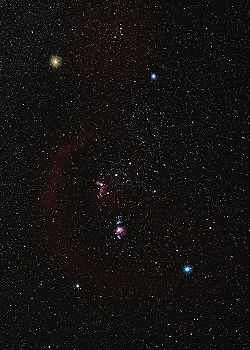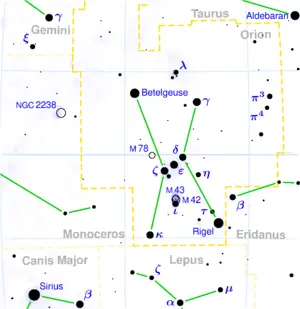Constellation
In common usage, a constellation is a group of celestial bodies that appear to occur together in some recognizable arrangement. Traditionally, peoples of different civilizations observed various groupings of stars that appeared to be fixed patterns. Such groupings of stars were essentially arbitrary, and different cultures developed different constellations, although some of the prominent ones tended to recur.
The formal astronomical definition of constellation is slightly different. A group of stars that can be connected to form a figure or a picture is called an asterism, whereas a constellation is a defined area on the sky. The International Astronomical Union (IAU) divides the sky into 88 official constellations[1] with exact boundaries, so that every direction or place in the sky belongs within one constellation. They are mostly based upon the constellations of the ancient Greek tradition, passed down through the Middle Ages, and they contain the signs of the zodiac. The Sun appears to pass through the 12 constellations of the zodiac (plus Ophiuchus), and ancient Greek astronomers believed they had some special significance.
Some well-known constellations contain striking and familiar patterns of bright stars. Examples are Orion (outlining the figure of a hunter), Leo (outlining the form of a lion), Scorpius (outlining a scorpion), and Crux (a cross shape).
The term constellation is also used to describe the arrangement and orbits of artificial satellite systems, such as those of various Global navigation satellite systems including GPS.
Asterisms
A star pattern may be widely known but may not be recognized by the International Astronomical Union. Such a pattern of stars is called an asterism. An example is the grouping called the Big Dipper (North America) or the Plough (United Kingdom).
The stars in a constellation, or asterism, rarely have any astrophysical relationship to each other; they just happen to appear close together in the sky as viewed from Earth and typically lie many light-years apart in space. However, one exception to this is the Ursa Major moving group.
Background
Very early in human history, people began clumping various stars together in connect-the-dots, stick-figure patterns. As noted above, the grouping of stars into constellations was mostly arbitrary, although some obvious groups were repeated, such as Orion and Scorpius. Historically, without an "official" list, there was really no difference between a constellation and an asterism. Anyone could arrange and name a grouping that might or might not be generally accepted. Nonetheless, some modern, well known constellations go back at least as far as the Sumerians.
Our current list is based on that of the Greco-Roman astronomer, Claudius Ptolemy of Alexandria (about 85–165). His list of 48 constellations was accepted as the standard for 1800 years. As constellations were considered to be composed only of the stars that constituted the figure, it was always possible to use the leftover, non-figure ("amorphic") stars to create and squeeze in a new grouping among the established constellations.
Two astronomers particularly known for attempting to expand Ptolemy's catalog were Johann Bayer (1572–1625) and Nicolas Louis de Lacaille (1713–1762). Bayer listed a dozen figures that had been suggested since Ptolemy's day; Lacaille created new groups, mostly for the area near the South Celestial Pole, unobserved by the ancients. Many of their proposed constellations have been accepted, the rest remaining asterisms, mostly obsolete. Clarification was necessary to determine which groupings are constellations and which stars belonged to them.
This situation was finally regularized in 1930, when the International Astronomical Union divided the sky into 88 official constellations with precise boundaries. Any other grouping is an asterism.
Drawing the boundaries
The constellation boundaries were drawn up by Eugène Delporte in 1930, and he drew them along vertical and horizontal lines of right ascension and declination. However, he did so for the epoch B1875.0, the era when Benjamin A. Gould made the proposal on which Delporte based his work. The consequence of the early date is that, due to precession of the equinoxes, the borders on a modern star map (such as for epoch J2000) are already somewhat skewed and no longer perfectly vertical or horizontal. This skew will increase over the years and centuries to come.
Ancient Greek constellations
The first ancient Greek works that dealt with the constellations were books of star myths. The oldest of these was a poem composed by Hesiod around the eighth century B.C.E., but only fragments of this work survive. The Greeks knew that these constellations were based on superstition. The most complete existing works dealing with the mythical origins of the constellations are by the Hellenistic writer known as pseudo-Eratosthenes and an early Roman writer styled pseudo-Hyginus.
Chinese constellations
Chinese constellations are different from the Western constellations, due to the independent development of ancient Chinese astronomy. Ancient Chinese skywatchers divided their night sky in a different way, but there are also similarities. The Chinese counterpart of the 12 western zodiac constellations are the 28 "Xiu" (宿) or "mansions" (a literal translation).
Indian constellations
In Hindu (Vedic) astronomy, the term rashi means constellation. There are twelve rashis along the ecliptic, corresponding directly to the twelve western star signs. These are, however, divided into 27 Nakshatras, or lunar houses.
Dark cloud constellations

Members of the Inca civilization identified various dark areas in the Milky Way as animals, and associated their appearance with the seasonal rains. These areas are commonly referred to by modern researchers as dark cloud constellations[2] or dark nebulae. Australian Aboriginal astronomy also used dark nebulae in some constellations, the most famous being the "emu in the sky" whose head is formed by the coalsack.
Constellation names and star designations
All modern constellation names are Latin proper names or words, and some stars are named using the genitive (or sometimes the ablative) of the constellation in which they are found. These are formed by using the usual rules of Latin grammar, and for those unfamiliar with that language the form of the genitive is sometimes unpredictable and must be memorized.
Some examples are as follows:
- Aries → Arietis
- Gemini → Geminorum
- Lepus → Leporis
- Libra → Librae
- Pisces → Piscium
- Taurus → Tauri
- Virgo → Virginis
In addition, all constellation names have a standard, three-letter abbreviation assigned by the International Astronomical Union. For example, Aries becomes Ari, Pisces becomes Psc, Sagittarius becomes Sgr and Ursa Major becomes UMa.[1]
Identification of stars within a given constellation includes the use of Bayer designations such as Alpha Centauri, Flamsteed designations such as 61 Cygni, and variable star designations such as RR Lyrae. However, many fainter stars will just be given a catalog number designation (in each of various star catalogs) that does not incorporate the constellation name. Frequently, the abbreviated form of the constellation name is used in the star designation, e.g. Alpha Cen, 61 Cyg, RR Lyr.
See also
Notes
- ↑ 1.0 1.1 Ian Ridpath, Constellations. Retrieved September 23, 2008.
- ↑ Pomona, The Incan View of the Night Sky: Stars, Constellations, and Dark Clouds. Retrieved September 23, 2008.
ReferencesISBN links support NWE through referral fees
- Chen, P.K. 2007. A Constellation Album: Stars and Mythology of the Night Sky. Cambridge, MA: New Track Media. ISBN 978-1931559386.
- Dickinson, Terence. 2006. NightWatch: A Practical Guide to Viewing the Universe, 4th edition. Buffalo, NY: Firefly Books. ISBN 978-1554071470.
- Heifetz, Milton D., and Wil Tirion. 2004. A Walk Through the Heavens: A Guide to Stars and Constellations and Their Legends, 3rd edition. Cambridge, UK: Cambridge University Press. ISBN 0521544157.
- Kerrod, Robin. 2002. The Book of Constellations: Discover the Secrets in the Stars. Hauppauge, NY: Barron's. ISBN 0764154400.
- Ramotowski, Becky. 2007. Secrets of Stargazing: Skywatching Tips and Tricks. Cambridge, MA: Sky Pub. ISBN 978-1931559409.
External links
All links retrieved March 20, 2017.
- The Constellations. International Astronomical Union. (Including high quality maps.)
- The constellations. astronoo.com.
- Star Tales Ian Ridpath. (Origins and mythology of the constellations.)
- The Constellations.
- The Deep Photographic Guide to the Constellations.
- Celestia. (Free 3D space simulation; OpenGL.)
- Stellarium. (Free, 3D open source planetarium; OpenGL.)
- The Constellations and their Stars. (Interactive Sky Charts; allows navigation through the entire sky with variable star detail, optional constellation lines.)
- Hyginus, Astronomica Part 1, translated by Mary Grant. (Greco-Roman constellation myths.)
- Heavens Above. (Observe satellites, space shuttles, constellations, comets.)
| |||||
| ||||||||||||||||||||||||||||||||
|
Astronomy | Constellations of the Zodiac | Astrology | ||||||||||||
| Aries | Taurus | Gemini | Cancer | Leo | Virgo | Libra | Scorpio | Sagittarius | Capricorn | Aquarius | Pisces | |
Credits
New World Encyclopedia writers and editors rewrote and completed the Wikipedia article in accordance with New World Encyclopedia standards. This article abides by terms of the Creative Commons CC-by-sa 3.0 License (CC-by-sa), which may be used and disseminated with proper attribution. Credit is due under the terms of this license that can reference both the New World Encyclopedia contributors and the selfless volunteer contributors of the Wikimedia Foundation. To cite this article click here for a list of acceptable citing formats.The history of earlier contributions by wikipedians is accessible to researchers here:
The history of this article since it was imported to New World Encyclopedia:
Note: Some restrictions may apply to use of individual images which are separately licensed.

